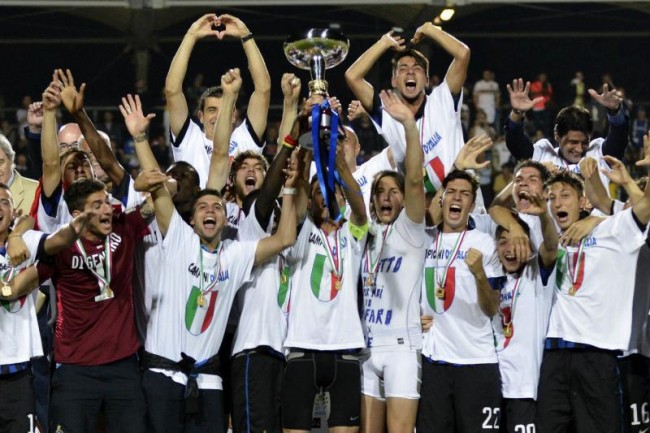As a part of the expansion of SempreInter.com, it is a pleasure to introduce our newest editorialist. None other than Hussein Marhoon, great Interista and great person. Here is his first text:
On the 25th March 2012, Inter’s Primavera team were crowned champions of Europe following a 5-3 win on penalties against Ajax in the final of the inaugural edition of the NextGen Series. That triumph came in middle of a season (2011-2012) filled with disappointments for the Nerazzurri and it was a much needed tonic for their tifosi. It also led President Massimo Moratti to sack the cultivated Claudio Ranieri and appoint the protagonist of the NextGen triumph, the rookie Andrea Stramaccioni in his quest to change the club’s fortunes.
Andrea Stramaccioni did fairly well as a caretaker coach in Inter’s last 9 matches in 2011-2012 season and only missed out on Champions League qualification on the final day of the season following a 3-1 away defeat to Lazio. His good run led to President Moratti to entrust him to lead the team in 2012-2013 season.
The NextGen triumph and Stramaccioni’s appointment has given the tifosi hope to finally realize a long lasting dream of seeing more Primavera players integrated into the first team. However, it didn’t work out during Stramaccioni’s and Inter’s ‘cursed’ 2012-2013 season. Why? Well, it’s a bit complicated…
Inter’s youth sector (Primavera, Berretti, Allievi and Giovanissimi Nazionali) is the most successful in Italy in the last 10 years. Inter’s youth teams reached 24 national finals and won 13 of them during the last decade. They also showed that they are good at the continental level by lifting the NextGen Series trophy in 2012. Despite all these successes, only a handful number of youngsters made it to the first team and not many of them consolidated their spots. So what’s really wrong?
So many questions have been raised by the Nerazzurri faithful with regards to that issue, especially when the club is going through a difficult period economically and it doesn’t have the spending power it used to have back in yesteryears. The main question remains, why can’t we rely on the youngsters?
There are many aspects involved in answering that question, and for this article I chose two aspects to analyze the problem: Competition Level and Mentality.
Competition Level: Unlike in other top European footballing nations like Spain or Germany, Competition Level in the Primavera sector is below the required standards. In Spain and Germany, clubs have reserve teams that play their trade in lower divisions (as high as the second division in Spain’s case) against teams that fight for promotion. Hence, youngsters over there get a real feel of how competition is at a very young age. World class players like ThomasMüller (started at Bayern München II), Juan Mata (Real Madrid II), Mario Götze (Borussia Dortmund II), Pedro (Barcelona C and then Barcelona B) are just few names of players that actually came through the ranks thanks to this system. In Italy, a player like Samuele Longo remained playing subpar Primavera football until he reached 20 and then was loaned to relegation threatened La Liga side Espanyol where he failed to meet the expectations and soon became not more than a fringe player.
Mentality: Results come first and foremost for Italian teams. Well, some will argue that this is the case everywhere else, but when you see a mid table team like Catania sporting 11 experienced players from Argentina you just think, why would a top team depend on inexperienced unprepared youth like Inter’s Primavera NextGen winning captain Andrea Romanò or Daniel Bessa if they can’t compete against seasoned players like Sergio Almirón or Mariano Izco? That’s not the only issue though; since teams like Catania depend on the likes Almirón and Izco (and get the required results), this means that the likes of Romanò and Bessa find it hard to get into any Serie A team to gain the required exposure and experience and usually end up playing with teams in Serie C1 (in Romanò’s case where he only played for 425 minutes in 6 matches) and Serie B (in Bessa’s case where he played for 73 minutes in 3 matches). Romanò represented Italy at every youth level (Under 16s, 17s, 18s and 19s) but at the tender age of 19 he can’t convince any Serie A team to take him aboard and rely on him. The trend is unless you are already an established player, you will not get your chance at the top flight.
To conclude, we can say that Inter’s issues with youth are the same issues that Italy has with them. Despite the economic hardships facing Italian calcio, we still have not seen any real initiatives for real reforms, especially reforms related to improving the youth sectors. The FIGC changed the format of the Primavera league lately to make it look like a reserves league (with only the 20 Serie A teams being able to compete in it) but this measure hardly addresses the real issues.
Youth players in Italy will continue to find it hard to make their mark at the top level because most of them are not up to the standards. It is not all their fault though, they need the help of a system that can bring them up to the required standards and also need a dramatic change in mentality for them to ever make a real impact at the top level.





